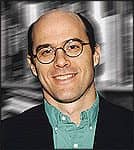
|
The Hearing Review saw its first edition hit the mailboxes 15 years ago this month. Our cover for that issue featured a couple in a very loving and somewhat suggestive embrace with the man wearing a bright, conspicuous, multicolored Beltone ITE—a fairly racy and unorthodox hearing aid for its time. To put things into historical context, in January 1994, Nancy Kerrigan got roughed up by some friends of Tonya Harding, Lorena Bobbitt (perhaps the most appropriately named person in memory) was acquitted of an impromptu surgery on her philandering husband by reason of temporary insanity, a different Clinton was in the White House, and I had hair (well, some hair).
We first published HR from a tiny office in an abandoned wing of a library built by Andrew Carnegie for the City of Duluth, Minn. HR’s founder, Lars Fladmark, hung a sign on all of our newly painted, but otherwise bare, office walls that stated: “We shall publish good magazines here. At a profit if we can, at a loss if we must. But, always, good magazines.” In my admittedly biased opinion, since that time, HR has been an editorially driven product that has presented hearing care events from a unique unbiased perspective, with often—like our first cover—unorthodox and far-reaching viewpoints. We have prided ourselves on presenting new perspectives and being at the vanguard of the major trends in hearing care, offering some of the field’s most influential (and often first) articles on deep fittings and CICs, digitally programmable parameters, directional microphone technology, DSP hearing aids, new counseling techniques, open-fit BTEs, and vestibular management, to name a few.
The Internet as an integral work companion. In January 1994, all the articles I received came via fax or regular mail. Like many people, I had a personal e-mail account, but our office didn’t have Internet access. Today, when a fallen tree knocks out my link to the server or I’m otherwise cut off from the Web, there is almost no practical way to do my job.
In the same way, our magazine and readership now rely on HR’s Web site and e-communications for news, articles, product information, and other e-media features—so much so that I would say the magazine and Web site are inseparable parts of the whole. Our Web site at www.hearingreview.com draws an average of about 850 dispensing professionals each day (about 800 to 1,300 every workday) who regularly access the site for its archived HR and HRP articles, our weekly e-newsletter The Insider, our search engine, daily news updates, and The HR Worldwide Registry. We also have a loyal “overseas” following with more than a quarter (28%) of our visitors hailing from outside the United States and Canada.
Although we only started it in December, our newly launched HR Science and Technology Thursday Podcast has already been accessed by about 3,000 visitors, and this is an e-media feature that we’re truly excited about. Using 10-to 20-minute MP3 recordings that can be listened to “on the spot” or downloaded, we are interviewing the authors of some of the world’s most interesting hearing research and technology. For example, in December, we interviewed Brian Moore, PhD, about his research on cochlear dead zones, as well as Richard Tyler, PhD, and Sergei Kochkin, PhD, about tinnitus and the efficacy of hearing aids as a treatment method. This month, we’ve interviewed scientist Kathleen Pirog Revill, PhD, about how the brain anticipates words from incoming auditory information; Ida Institute Director Lisa Lotte Bundesen about a unique seminar called “Defining Hearing”; epidemiologist Kathleen Bainbridge, PhD, on the link between diabetes and hearing loss; and audiologists Richard Seewald, PhD, and John Bamford, PhD, on the progress made in pediatric amplification during the past 10 years (a theme that will carry on through February). I think anyone tuning into these podcasts will come away with great new information and ideas from key researchers and scientists. You can access the podcasts at www.hearingreview/sciencetech.
And you’ll see a lot more of these kinds of innovations from HR. With the continued help and direction from our readers, we’ll continue to offer the information you’re looking for—in easy-to-access formats—during 2009 and beyond.
Karl Strom
Editor-In-Chief





